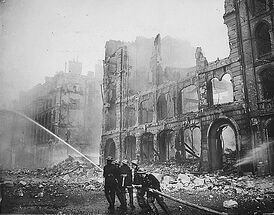
Firefighters in London after an air raid
| “ | It was night when London was ringed and stabbed with fire. | ” |
| ~ Ernie Pyle |
The Blitz was the continual strategic bombing of Great Britain that occurred from September 7, 1940 to May 10, 1941. The purpose of the Blitz was intended to be that of a morale-crusher. The Blitz ended on 16 May, when most of the Luftwaffe was reassigned East for the imminent invasion of Russia.
History[]
The first German raids on British cities had already taken place by the end of August 1940, when Birmingham and Liverpool were attacked, but on 7 September the Blitz intensified when around 950 German aircraft attacked London. It was the first and last mass daylight raid on London, but it heralded the first of 57 consecutive nights of bombing. In early November, Luftwaffe chief Reichsmarschall Herman Göring ordered that the air offensive against cities, industry and ports had to be conducted entirely under cover of darkness. The new strategy was showcased by a massive attack on Coventry on 14 November, which destroyed much of the city, including all but the spires of St Michael's Cathedral and the Grey Friars' Church. Attacks on Birmingham, Southampton, Bristol, Plymouth and Liverpool followed, but they proved less effective.[1]
The daylight raid alone caused some 300 civilian deaths and a further 1,300 serious injuries; by the end of the Blitz, around 30,000 Londoners would be left dead, with another 50,000 injured. Fortunately, millions of children, mothers, patients and pensioners had already been evacuated to the countryside.[1]
The end of the Blitz saw a return of evacuees and the start of the reconstruction of London - even though building materials were in short supply. The docks had been devastated, as had many industrial, residential and commercial districts, including the historic heart of the City.[1]
